{How I Write a Bible Study} Part 2 – Slow WAY down
Last time I told you about how I study a book of the Bible I’m going to write a Journal and Doodle Study on (you can see the first part here). I don’t have a step-by-step process, but rather a plan to go as slow as I possibly can. That’s 100% my plan and goal. Slow. Digging in deep and slowing way down. So, let me show you what I did next in my study of 1 Peter. (These two pages took me about 5 days (5-8 hours) of studying and thinking. It’s a comfortable speed that helps me think, meditate, and ask questions of the text.
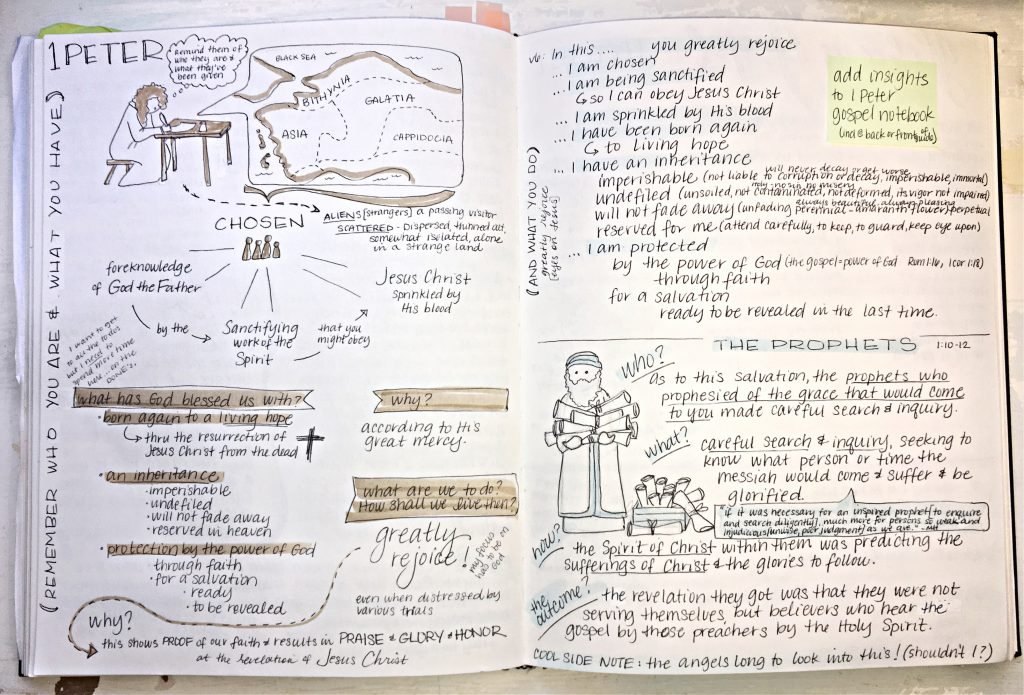
If there are locations mentioned, I always like to look up a map of the areas referred to. Most of the time I just search online using the words of the book and chapter. For example, for that map I searched “1 Peter map” and there were a bunch of maps that I could use to make my doodle.
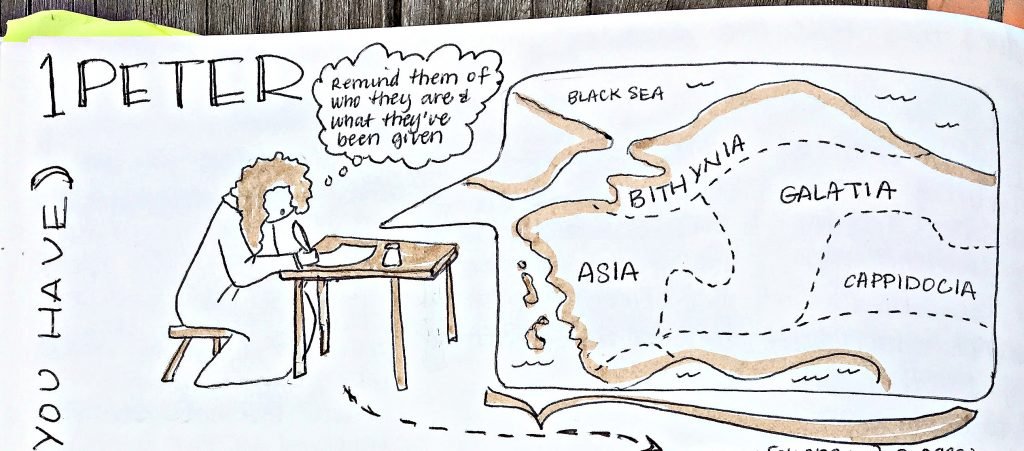
I always like to include a map in my studies if I can, it helps ground me on where it took place, and that it was and is an actual real place, with actual real people. In this case, Peter was writing to pretty much the whole area of modern day Turkey, where the believers were scattered. Of course I had to doodle Peter too, and summarize what I learned about why he wrote this letter to them in a little thought bubble.
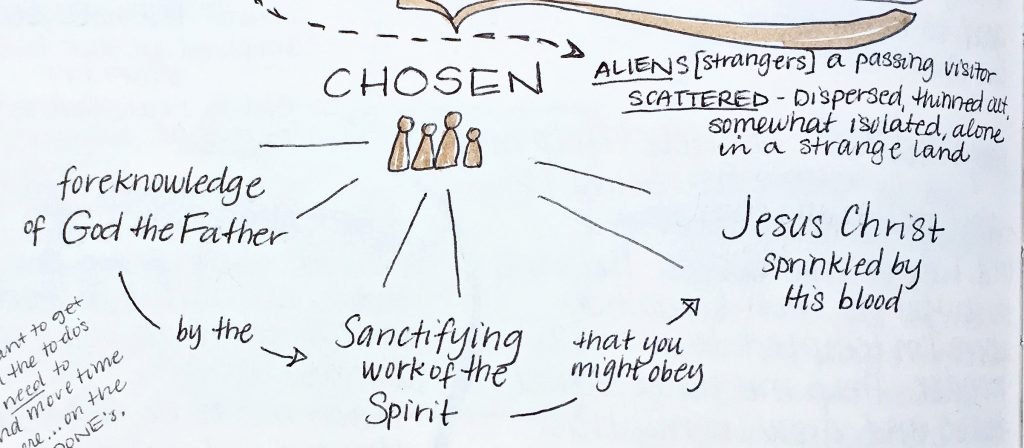
The next section I wanted to think more about was verse 2, the people who Peter was writing to. I made a super simple doodle of some “people” and labeled them chosen… then I wrote what verse 2 says about them. I also looked up a few of the words even though I’m always sure that I already know what they mean. It’s often enlightening to know the true meaning rather than my vague impression, plus there’s usually good insight of things that I might not have considered. Bible study is best when it’s done slowly and thoughtfully. We’re not in a race.
(Brutally honest side note: I always come to my study time thinking “I”m not going to get anything out of it this time,” or “This is going to be boring.” It’s a default attitude that seems to haunt me. But, when I press on and sit down and focus, those thoughts are always ALWAYS wrong.)
I noticed that this one sentence at the beginning of of Peter’s letter holds the Trinity. And it gives a short description of each person of the Trinity’s role in the life of believers. The Father has the plan, the Spirit sanctifies — but not for the result of being sanctified — but so that we might obey Jesus. It’s as one of my friends said recently, it’s not sanctification for the sake of looking pretty and beautiful and holy, it’s sanctification so I can obey better and better, so I might submit quicker and quicker to Jesus.
And that is where I stopped for the day. It gave me a lot to think about: Peter was writing to encourage these believers because they felt like they didn’t really belong. They were dispersed. Some probably had to leave friends and family and move to a completely new place, some were isolated and alone, some families had been torn apart or thinned out. And Peter, in one long sentence, acknowledged their hard situation but immediately encouraged them to turn their eyes back to who God is.
(Another brutally honest side note: I moved on from this section way too fast. Why? Because I think I already know this stuff and agree, quickly skimming over it, wanting to get to the “good stuff”. How sad. This IS the good stuff! This is the most important part– the part I nod and agree with yet don’t pause and consider! Ugh! I discovered that I had just skimmed this section six pages later in my journal, when a verse referred back to it. So I added another page for this passage right where I was in the journal. It’s a bit out of order if you’re flipping through the journal, but through the magic of the internet, it’s in order for you here!)
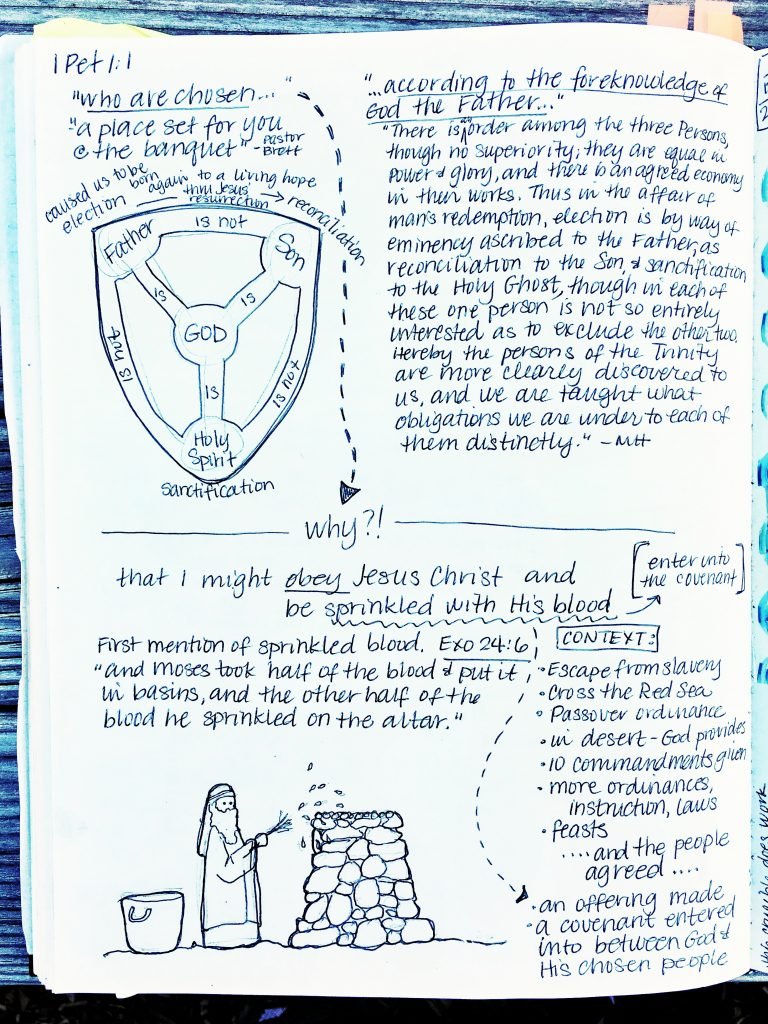
I think this was the first time in this study where I looked at a commentary. I am trying to build the habit to use my mind to think through what I’m learning, not just search for quick answers and other people’s thoughts. But when I do use a commentary (usually for tricky passages) my first choice is always Matthew Henry’s commentary. I wrote out part of it that helped explain the Trinity a bit more. Next, I looked up some cross references to “sprinkled blood” and found the first instance is in Exodus, which I remembered from when I went through Exodus in the I Will Meditate guide.
After I worked on this additional page, I wrote myself a note back on the first page. I’m praying the Lord helps me remember that the best part is always the part of what He has done!

And that’s where I stopped for that day. However, since I want to work through this entire page for this blog post, the next time I picked this up, I worked through this last part:

This part (verses 3-5) was a section that seemed to be a good thought to zoom in on. Verse 2 was addressing the recipients, and verse 6 starts talking about trials. So this seemed like a good next section. One thing that I can’t make a huger point of though, is to always keep Scripture in context. Context is King! Always read a large section of the scriptures surrounding what you are zooming in on to keep it in context and not start pulling weird thoughts out of the air.
I noticed that this section lists three things we have as believers:
1. He caused us to be born again to a living hope (through the resurrection of Jesus Christ.) Again, not born again just to be born again and that’s it, but born again to a LIVING HOPE. Peter is getting believer’s eyes off their circumstances and onto what has been done for them.
2. He gave us an inheritance, then described that.
3. We are also protected by the power of God through faith (for a salvation…)
After looking over that list, I ask “why?” Why did He do this? Does the section give us any reason? And yes, right at the beginning it does: according to His great mercy.
Then I ask myself: “So what?” Why does this matter? What am I to do about it? How should I live in light of this? Verse 6 gives the answer: Greatly rejoice!
That got me thinking about how good He is to us. Why? Why is He so good? I always run out of room on my pages, so I grabbed a sticky note and asked and answered all that was swirling around in my head.

And that sticky note led directly into praise and prayer. It is so much easier to pray when I’ve been thinking deeply about Scripture. Prayer and praise flow naturally from it.
Summary
So if I had to summarize this blog post into points, I guess I would say:
1. Look up maps of locations mentioned.
2. Remind yourself of why the author wrote it (by doodling a picture of the author and thought bubble maybe?)
3. Keep everything in context. It’s very important to read what was before and after–large chunks of Scripture, the whole chapter if you can. You’ll start to connect things that you’ve read previously with things that come after, which is SUPER cool!
4. Move slowly, very slowly. Ridiculously slowly.
5. Look up words for more clarity, even if you know what they mean.
6. Look for points the author makes that might make good lists.
7. Make application as you can. Ask yourself “So what?” or “Why does this matter?” or “What is expected in light of this?”
8. Have lots of sticky notes on hand. To add more thoughts or things you missed.
9. Challenge yourself to exhaust every single sentence. Wring out all the goodness before you move onto the next section.
Ugh, that was a lot! Hope you hung in there! Thanks for going along on the journey with me. 1 Peter is AMAZING!

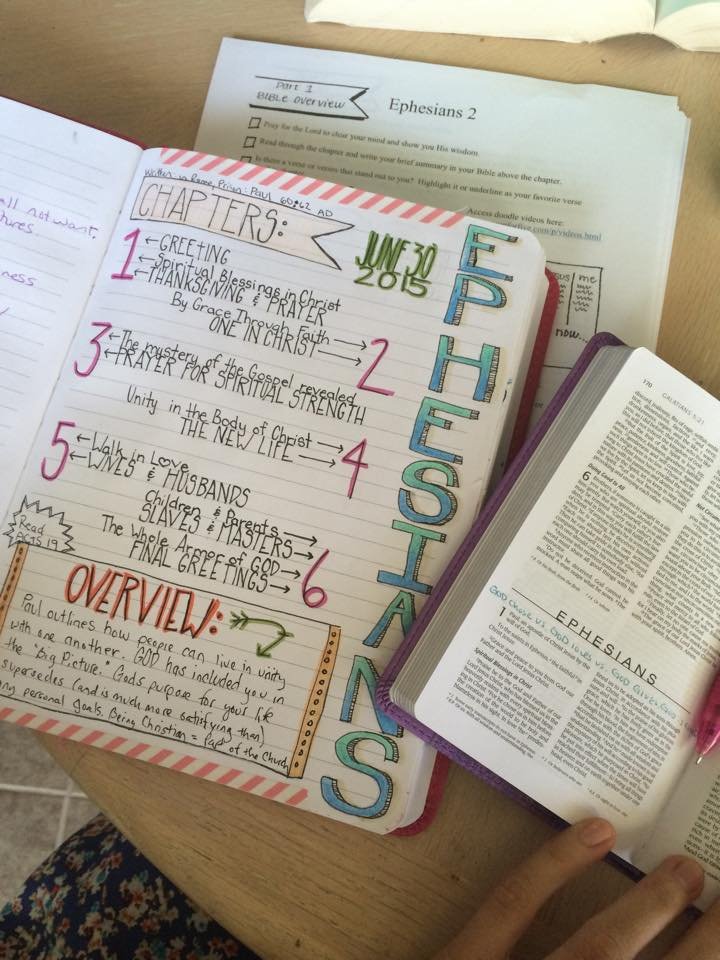





I loved your TRINITY illustration. It’s natural to look at the “is” and forget about the “is not”.
Thanks so much for this post. I have just started a new Bible study with some women from church. I’m trying to get them to slow down and dig for themselves. This is helpful.
As always, this is so helpful! I was reading in I Peter and noticing a lot of the parallels in James ( which is the book I am studying)! I may try to do a comparison of the two!
Thanks so much for this Kari. Finally a plan I can follow and use in any study I do.
That was wonderful! Thank you!!
Thank you Kari! This is very helpful and I appreciate you sharing your hard work. Please continue!
I thank you also Kari and haven’t made a comment before ( didn’t subscribe for a while) but all that you have shared has been such an encouragement and I thank God that you have continued in such great work.
When I am stuck in a hard to get a Bible study routine happening , your blog helps me.
I have done inductive study in the past but get lost in the instructions sometimes (all the to dos ) and I get off track. Filling up with head knowledge…
I had to go back and find your book studies I have downloaded in the past.
I forgot the reason for Bible Study.
I want to obey better and better so that I might submit quicker and quicker !
Thanks also for being real !